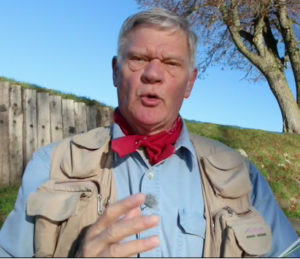Everybody likes dry fly fishing because its such a visual process. You see the fly. You see the fish take the fly. It’s an exciting process. It’s possible to experience the same visual excitement nymph fishing if you develop the right technique, says Gary Borger.
“Whether you’re fishing at the surface, just under the surface or at the bottom you can make it a process that is totally visual to the angler,” he says. But the process works only if the fly is on the bottom of the river and stays there throughout a drift, he says. “If you’re not on the bottom, you’re not doing what needs to be done and you will not catch fish. Period. A lot of people think they put on a couple of bead heads and heave them out there thinking they will sink and that’s not the case.”
The problem with getting flies to the bottom of a river is that the fastest current is always on the top. A weighted fly can drop through that current to the bottom, but the faster current at the top will always be creating drag on the line and drag on the fly beneath and compromise the presentation. Borger works around those problems by using leader lines weighted with split shotnot weighted flies.
“The split shot has more purpose than just sinking the fly to the bottom. Everybody thinks that’s the only purpose but its not. The job of the split shot is to anchor the fly against line drag that is pulling the line and fly back to the surface. Because if the fly line is on top of the water going at X speed and the fly is on the bottom going at one-half X, the line will pull the flyback to the top. The line will always go the speed of the fastest current. That’s the biggest problem in nymph fishing American anglers have had, period.”
“I put the split shot, 8 to 12 inches above the fly. The split shot anchors that fly near the bottom. Then I put an indicator about 3 to 5 feet above the fly. If the anchor works on the bottom, the indicator will be going one-half to two-thirds the speed of the water around it on the top,” says Borger. If it’s not, if the indicator is moving at the same speed as the surrounding surface water, then he advises adding more weight until the indicator slows down.
“Another thing the shot does is help set the hook. The split shot continues to move after the fish picks up the hook, so the shot then pulls the hook and helps make the set. The hook is set by the shot and then the indicator goes under. If you pull every time the indicator stops, you’rejust pulling your fly off the bottom. But if you wait for the indicator to go under there is a fish there.”
Borger is indifferent to what indicator a fisher uses. It can be a fly such as a Chubby Chernobyl, a tuft of wool or synthetic yarn, or one of dozens of commercial indicator productson the market. Regardless, it’s the weight that makes the indicator work. Combining the right weight with the indicator makes nymph fishing a truly visual process.

Gary’s Schedule
Friday May 3
8:30—Nymphing Top to Bottom
10:30-The Perfect Cast
1:30-Tying Demonstration, Down and Dirty Flies
3-Tying Demonstration, Unique Hackling Techniques
Saturday May 4
8:30-The Angler as Predator workshop
10:30-Tying Demonstration, Down and Dirty Flies
1-Continuing Education for Casting Instructors
